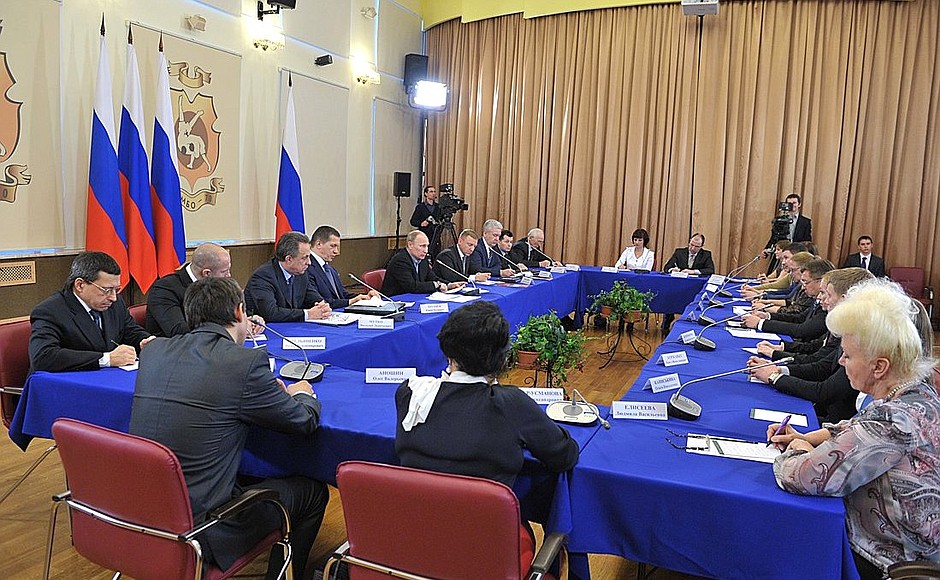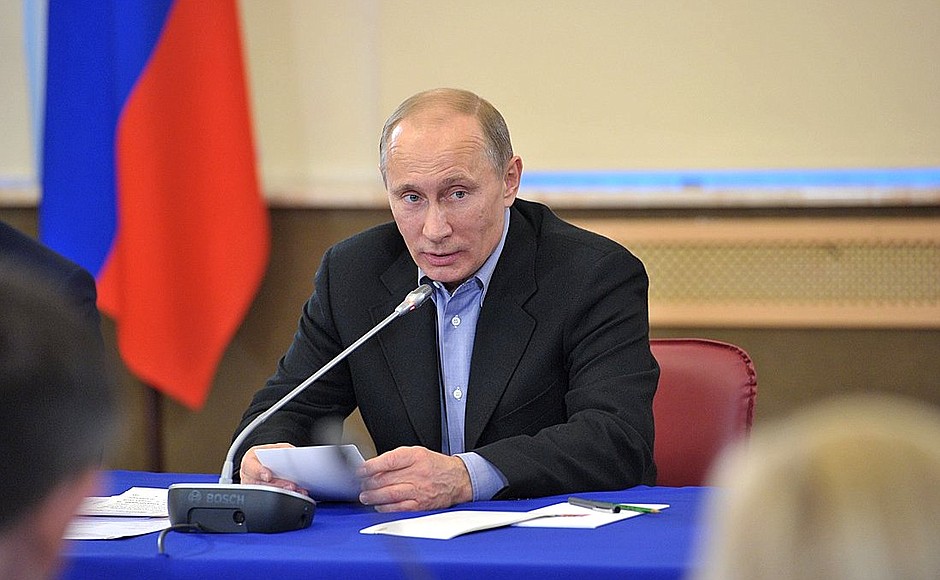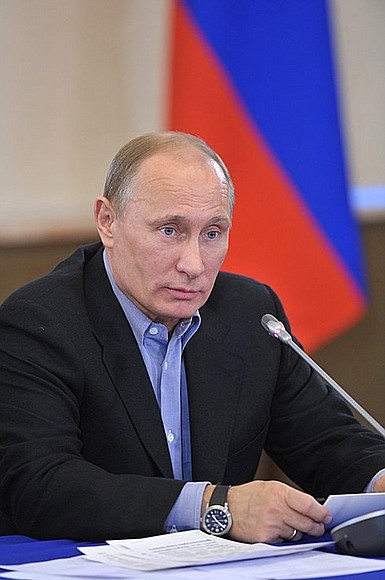President of Russia Vladimir Putin: Good afternoon friends and colleagues,
The heads of various federal agencies, educational establishments, and public figures are all here today, and it is in this broad-format gathering that we will discuss developing mass sport. This is a big issue that concerns practically every family in Russia. We will discuss children’s physical education and development of children’s and youth sport.
We have given this issue a lot of attention over recent years. Sport has rightly returned to being one of our state policy priorities. The change is clear, but it is still not enough, and so I propose that we discuss this today.
The infrastructure is developing of course, regional and municipal sports training centres are opening, and there are big efforts underway to promote a healthy way of life.
But frankly speaking, we have yet to see real fundamental change in the situation with mass sport, especially children’s sport. This is an area in which we lag far behind many other countries, including some of our neighbours.
Physical education remains at the margins of the overall education process and, among the competing leisure pursuits for children and teenagers, loses out to television, computers, and the seated way of life. And yet we all know that it is during our childhood years that healthy attitudes and attachments to sport are formed. Most important of all, as we discussed actively just before, is that this is the crucial time for forming the behaviour patterns that do so much to ultimately shape each individual’s quality of life and later successes.
We are seeing some very worrying trends today. The specialists say that children’s physical education is significantly worse in Russia now than it was a few decades ago.
The figures and facts are already known overall, but let me repeat a few of them nonetheless. Two thirds of children in Russia already have some form of chronic illness by the age of 14. Two thirds! Half of all schoolchildren have some kind of muscular and skeletal problems, and 30 percent have problems with their breathing and cardiovascular systems. Up to 40 percent of those called up for compulsory military service are incapable of fulfilling the minimum physical education norms for military servicemen.
Clearly, there are many reasons for this situation. Social problems are a factor, probably one of the biggest factors, and then there are the state of the healthcare system and the situation in families. Of course, if we want to achieve the objectives we are here to discuss today, we must work consistently to address all of these issues too. We also have to revise our approach to physical education and develop it as a comprehensive, effective and modern system.
See also
We are to begin with the key players in this process – school heads and education managers – and put in place a system of incentives for them, while at the same time making their obligations clear too, and including performance in this area in overall assessments of schools’ work. The directors of schools and kindergartens will thus have more incentive to ensure that all children get involved in sport.
Of course, school heads need the relevant means at their disposal in order to achieve these goals. We should address the personnel shortage, modernise the methodological base, and resolve the equipment problem.
Only around 83 percent of general educational schools have school gyms at the moment. Of these, more than 42 percent need to be improved and rebuilt. But every school should have modern and well-equipped gym. This is an issue we must resolve in the nearest future.
Another important point is that there should not be children who just sit on the bench watching during physical education classes. All children without exception should take part. Of course there are children with particular health problems that set limits on what they can do, but rather than simply exempting them from physical education classes, the solution here is to develop tailored corrective programmes to suit them and get the specialists involved in this work.
Finally, I think it is fitting too to recall positive examples from past decades, when we used to have the Ready for Labour and Defence system in place that set physical education norms for people of various age groups. This was an effective and functioning system. True, over time it gradually became more of a formality, but it did work nevertheless and gave us a unified set of physical education standards and performance measurement criteria that everyone could use. This was very important because it is important to have guidelines.
Reviving this system — in a modernised new form of course — could be a very positive step. There are various names one could give it. The last thing I would want is to use some kind of bureaucratic-sounding acronym. We maybe won’t come up with a suitable name right here and now, but we could certainly look at reviving this system, and we could ask people to get involved in choosing a name that would help make it attractive.
I ask the Education and Science Ministry and the Sports Ministry to focus on this. The Council for the Development of Physical Culture and Sport should also take part in this work. We will examine the resulting proposals at one of the council’s meetings, including proposals from citizens and public organisations.
Furthermore, I think that physical education results of students who fulfil the requirements of the standards I just spoke about should be included in their school-completion certificates and taken into account when entering universities.
Turning to another issue, in order to get children and young people involved in sports we always had a busy calendar of sports events and competitions. These really were mass events that helped us to spot the talent that would go on to form the pool of top-level sportspeople. Today, we have competitions taking place under the President’s aegis, presidential competitions that fulfil this purpose, but we have to analyse their effectiveness, see what problems there might be, and think of ways to improve them, including through drawing on the experience of school tournaments such as Golden Puck, Leather Ball, White Boat, and other national events. Overall, these competitions are quite well organised and there are a lot of children taking part, but we are to examine all the positive experience around and keep moving forward.
Effective organisation and a good management model are important for successfully developing children’s sport. The problem is that the Education and Science Ministry currently does not have any organisation specifically responsible for physical education and student sport, which, as we know, is a huge area of work.
We also need to improve financing mechanisms for physical culture and mass sport, above all as concerns allocating budget money and monitoring its effective use.
Under the current laws, this work is the responsibility of the regions, but we do have to put in place instruments that will expand mass sport’s financial base and include the relevant measures in the Development of Physical Culture and Sport State Programme.
Supporting children’s sport and physical culture is also without question an important area where charity activities, citizens, and organisations can all play a part. We are to encourage business to take part in this kind of work. I instruct the Government to draft the relevant incentive measures.
All of these steps should work towards the main goal, which is to make our nation healthier and achieve harmonious development for each individual. Our children should be strong, healthy, love sport, have the opportunity to play sport, and be able to stand up for themselves, their friends and families, and ultimately, for their homeland. It is our duty to ensure all the conditions required for achieving this goal.
<…>


